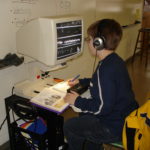
Americans with disabilities and those with related special education needs will be able to use smart phones, the internet, and other technologies that are staples of life and work more easily under a technology access bill signed into law Oct. 8.
Such a step has been a priority of advocates for the millions of Americans with disabilities such as blindness or loss of hearing.
In the East Room of the White House, where he was flanked on stage by lawmakers and Stevie Wonder, President Barack Obama portrayed the occasion as another step in guaranteeing equal technology access, opportunity, and respect for all Americans.
He recalled celebrating this year’s 20th anniversary of the Americans with Disabilities Act, banning workplace discrimination against qualified people with disabilities and requiring improved access to public places and transportation for those with disabilities and special education needs.
“We’ve come a long way but even today, after all the progress that we’ve made, too many Americans with disabilities are still measured by what folks think they can’t do, instead of what we know they can do,” Obama said.
The new law “will make it easier for people who are deaf, blind, or live with a visual impairment to do what many of us take for granted,” he said, from navigating a TV or DVD menu to sending an eMail message on a smart phone.
“It sets new standards so that Americans with disabilities can take advantage of the technology our economy depends on, and that’s especially important in today’s economy when every worker needs the necessary skills to compete for the jobs of the future,” Obama said of the technology access law.
In one corner of the East Room, sign language interpreters translated Obama’s remarks as he spoke. Across the room, his words scrolled on a large video monitor with help from a stenographer who transcribed them.
Under the law, the quality of life will improve for 25 million people who are blind or have difficulty seeing, along with the estimated 36 million people who are deaf or hard of hearing, advocacy groups say.
“It’s very exciting that the legislation has passed, and it has the potential to really make a difference in the lives with students with special needs,” said Tracy Gray, director of the National Center for Technology Innovation. “It will mandate that technology tools are accessible to all individuals, and it will open the door to access for individuals who have heretofore been excluded from videos and other emerging technologies. It really keeps them actively engaged.”
Nondisabled people stand to benefit, too. They might find the devices and screens easier to use.
The technology access law sets federal guidelines that require the telecommunications industry to:
- Make getting to the internet easier by improving the user interfaces on smart phones.
- Provide audible descriptions of on-screen action to help the blind more fully enjoy television.
- Add captions to online TV programming to help the deaf.
- Make the equipment used for internet telephone calls compatible with hearing aids.
- Add a button or other switch to television remote controls for simpler access to closed captioning on television.
Paul Schroeder, a vice president at the American Foundation for the Blind, said many blind or deaf people have had to spend hundreds of dollars on costly accessories or software to make their cell phones and other devices easier to use.
“We hope that companies will start working immediately on making solutions available and affordable for people with disabilities,” he said.
Blind since childhood, Schroeder described the bill as “life changing.”
“As a person who is blind, it will bring some of the new technologies that are changing the workplace, education and leisure into my hands,” he said.
- ‘Buyer’s remorse’ dogging Common Core rollout - October 30, 2014
- Calif. law targets social media monitoring of students - October 2, 2014
- Elementary world language instruction - September 25, 2014



Comments are closed.